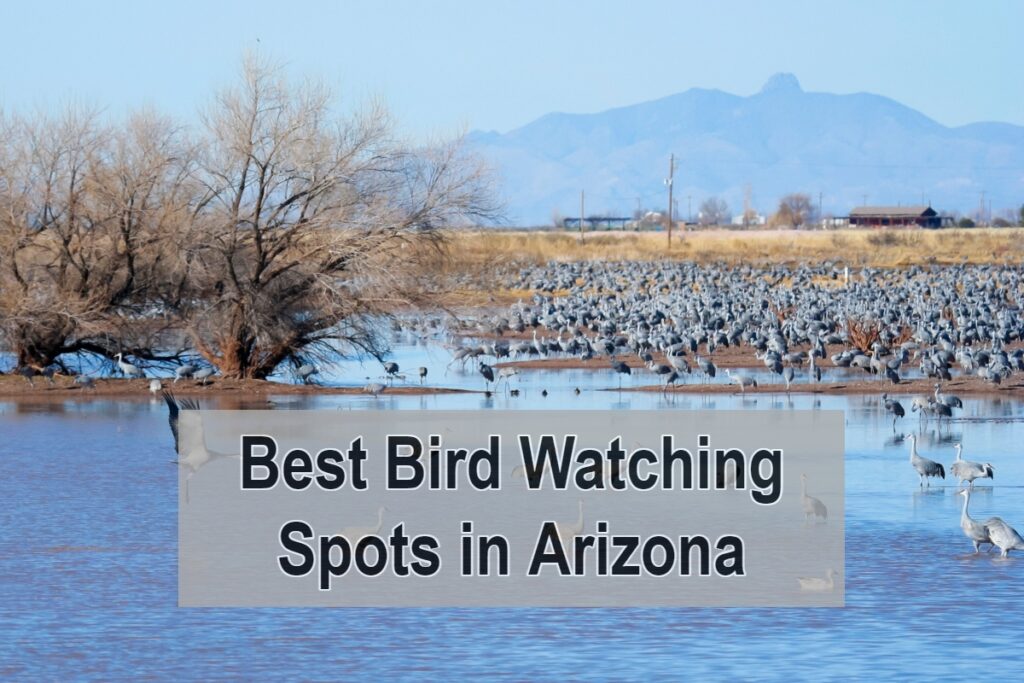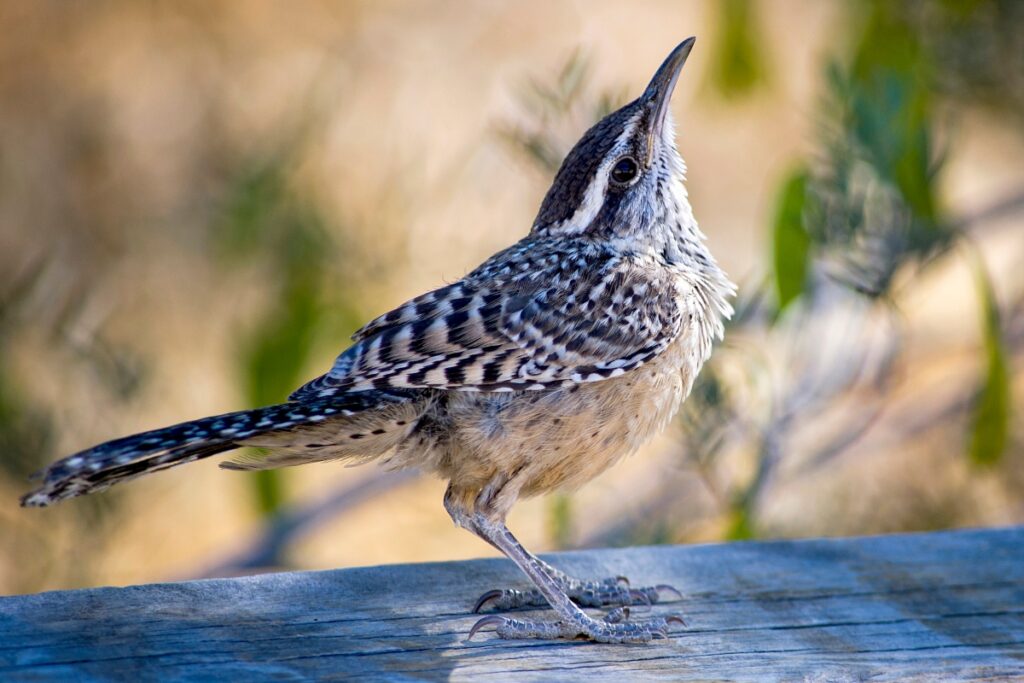As an Amazon Associate, we earn from qualifying purchases with no additional costs for you.
Arizona has one of the highest bird species richness of any land-locked state at 550 species. The state is mainly known for its deserts and the Grand Canyon, a famous tourist attraction. However, Arizona encompasses much more than this. This guide will help you choose the best places you should visit for bird watching in Arizona.
The best bird watching spots in Arizona are in the canyons at Madera Canyon, in the Chiricahua Mountains and Huachuca Mountains, and along the Catalina Highway up to Mount Lemmon. Other good spots are in riparian areas and at wastewater treatment plants.
The table below shows the most exciting birds you can see at my top 14 birding spots in Arizona.
| PARK | INTERESTING BIRDS YOU CAN SEE |
|---|---|
| Sweetwater Wetlands | Virginia Rail and Sora |
| Madera Canyon | Acorn Woodpecker and Northern-Beardless Tyrannulet |
| Chiricahua Mountains | Elegant Trogon and Magnificent Hummingbird |
| Huachuca Mountains | Red-faced Warbler and Rivoli Hummingbird |
| Riparian Preserve at Water Ranch | White Pelican and Wood Stork |
| Whitewater Draw Wildlife Area | Sandhill Crane and Northern Harrier |
| Boyce Thompson Arboretum State Park | Lawrence’s Goldfinch and Rufous-backed Robin |
| San Pedro Riparian National Conservation Area | Cassin’s Kingbird and Black Phoebe |
| Sierra Vista Environmental Operations Park | Chihuahuan Raven and White-faced Ibis |
| Patagonia-Sonoita Creek Preserve | Sinaloa Wren and Ruddy Ground-Dove |
| Patagonia Lake State Park | Gray Hawk and Zone-tailed Hawk |
| Mount Lemmon Highway | Mountain Chickadee and Scott’s Oriole |
| Watson Woods Riparian Preserve | White-winged Scoter and Red-breasted Merganser |
| Humphreys Peak | Three-toed Woodpecker and Green-tailed Towhee |
Read on for more information on my choices for the best bird watching spots in Arizona. I also discuss the birds to watch for and some of the habitats you can find in each spot.
TIP: If you want to check out the best pair of binoculars for bird watching, we recommend a pair of waterproof and fog-proof 8 x 42 binoculars like the Celestron – Outland X 8×42 Binoculars (Amazon link).
Best Places to Bird Watch in Arizona
Arizona is a prevalent state with bird watchers because of the many species found here and the unique types of habitats where you can spot birds.
TIP: Knowing how to spot the birds in your yard is key to enjoying visits from your winged friends as much as possible! The best sources are trusted books, I recommend using the following (Amazon links):
– National Geographic Field Guide to the Birds of North America
– National Audubon Society Birds of North America
1. Sweetwater Wetlands
This park is close to Tucson and is a wastewater treatment plant. These are always popular with bird watchers for providing suitable habitats for many birds. You always find a lot of birds on the water in wastewater treatment plants. Exposed muddy areas also attract shorebirds.
The park comprises several ponds surrounded by vegetation like willow trees and cottonwoods. The species list is at about 300 for the site.
Look for ducks and other waterfowl on the ponds, such as teals and grebes, and scan the trees for other birds. Birds seen here include the Ladder-backed Woodpecker, Verdin, and Marsh Wren.
Keep a look out for secretive marsh species like Sora and Virginia Rail. You should check the ponds for Black-necked Stilts and American Avocets as well.
2. Madera Canyon
This canyon is in the Coronado Forest on the western side of the Santa Rita Mountains. You can also see a lot of birds on the road on the way to the canyon.
Elf Owls, Whiskered Screech Owls, Acorn Woodpeckers, Zone-tailed Hawks, Northern-Beardless Tyrannulets, and Arizona Woodpeckers are at the canyon.
Other birds to watch out for include the Cordilleran Flycatcher, Hutton’s Vireo, Grace’s Warbler, and Sulphur-bellied Flycatcher. Hummingbird feeders are found at many lodges on the way to the canyon.
This is also a way to spot hummingbirds on your trip, but several different species of hummingbirds are found in the canyon, including Violet-crowned and Blue-throated Hummingbirds.
3. Chiricahua Mountains
These mountains are in the southeastern part of Arizona. Many unique birds are found in this area, and even on the way to the mountains, scrub in the nearby town of Portal has species like Curve-billed Thrasher, Black Phoebe, Bell’s Vireo, and Bridled Titmouse.
The best spot in the mountains for birds is Cave Creek Canyon. This is also located in the Coronado Forest.
Bird species to look for here include Montezuma Quail, Elegant Trogon, Magnificent Hummingbird, and Mexican Jay. The Chiricahua Mountains are an important bird area that has about 370 species of birds.
4. Huachuca Mountains
These mountains are just west of the Chiricahua. In this area, you should visit Ramsey Canyon Preserve, which has Anna’s Hummingbirds and Rivoli Hummingbirds. The area has semi-desert grasses but also pine and fir trees. There are also plants near Ramsey Creek, attracting more birds.
You can also drive to the Huachuca highlands, where you can find other birds like Red-faced Warbler and Yellow-eyed Junco. It would be best if you visited these Huachuca mountain sites between April and October. You can see most species of passerines, including hummingbirds, during the summer months.
5. Riparian Preserve at Water Ranch
This was established in 1999 as a wetland conservation area for waterfowl. The preserve is 110 acres in size and is located in Gilbert, Arizona.
You can see White Pelican, Little-blue Heron, and Wood Storks, besides many species of waterfowl. You can walk on trails and bird watching along the way in the trees lining these paths. At least 298 species of birds have been recorded here.
Some blinds make finding and seeing more secretive species a little easier. They have also established a Hummingbird and butterfly garden here, which you should check out.
6. Whitewater Draw Wildlife Area
This reserve is 1500 acres in size. The best time to go to this spot is between October and March, when thousands of Sandhill Cranes gather here.
Whitewater Draw Wildlife Area is also an excellent place to see Northern Harriers, which fly above marshes looking for prey. Peregrine and Prairie falcons have also been seen flying over the grassy areas, so you need to keep an eye out for these raptors.
Sora may be tricky to see, but they are present in the marshy areas here. Some waterfowl in the waters include Northern Pintail, Northern Shoveler, Cinnamon Teal, Green-winged Teal, Blue-winged Teal, Western Grebe, and Clark’s Grebe. You can use a walking path to see the cranes while looking out for other birds.
7. Boyce Thompson Arboretum State Park
This park is located in the high desert of Arizona. Habitats include the Sonoran desert, mesquite, and a man-made lake. There are trails you can walk on to look for birds.
At least 240 species have been recorded here, making this a good spot for bird watching. Species seen in summer include Hooded Oriole, Bell’s Vireo, Lawrence’s Goldfinch, Clark’s Nutcracker, and Rufous-backed Robin.
In spring, you can often see Anna’s and Costa’s Hummingbird. In winter, you can look for sparrows like the Fox Sparrow and White-throated Sparrow.
This park can have extreme temperatures, being very hot in summer and very cold in winter. This is worth bearing in mind if you are planning a visit. Boyce Thompson Arboretum offers bird walks and other activities at various times of the year.
TOP TIP: Read this Complete Guide to discover the best season for bird watching in your area. This article discusses bird wings and how different they all are!
8. San Pedro Riparian National Conservation Area
This riparian area follows the San Pedro River and is 57,000 acres in size. The two places to access this birding area are at Hereford and at the San Pedro House.
Several birds live and nest in the area. Over 370 species have been seen in the area. Look out for birds like Gambel’s Quail, Cassin’s Kingbird, Black Phoebe, and Gila Woodpeckers. Lucy’s Warbler and Abert’s Towhee are also often present. A complete checklist of the birds in this area can be used for your trip.
9. Sierra Vista Environmental Operations Park
It is an excellent move to visit this site after exploring the San Pedro Riparian National Conservation Area because it is close by. Sierra Vista is a water treatment plant with several waterfowl present, including at least 20 ducks and Pied-billed and Eared Grebe species.
You can also find waders like White-faced Ibis and Common Gallinule. Keep an eye out for Vermillion Flycatchers and Chihuahuan Ravens on the land.
10. Patagonia-Sonoita Creek Preserve
The area consists of riparian woodland that surrounds Sonoita Creek. You can find the following birds in spring and summer: Phainopepla, Verdin, Bushtit, Gila Woodpecker, Vermillion Flycatcher, and the uncommon Yellow-green Vireo, Sinaloa Wren, and Ruddy Ground-Dove.
On the way to the preserve, you should definitely stop at the Paton Center for Hummingbirds, where there are feeders where you can see hummingbirds.
TIP: Choosing the right bird feeder is crucial when you want to attract birds on your backyard. There are a lot of options on how and where to place a bird feeder. Check out my picks on different bird feeders below (Amazon links):
– Free-standing Bird Feeder
– Hanging Bird Feeder
– Bird Feeder with Camera
11. Patagonia Lake State Park
This park has a bird list of 300 species. It has a good combination of habitats, including the lake, desert scrub, and woodland. As a result of these different habitats, you can find many birds, such as the Broad-billed Hummingbird, Gray Hawk, Neotropic Cormorant, and Zone-tailed Hawk.
12. Mount Lemmon Highway
Mount Lemmon is 9,157 feet above sea level at its highest point. The Catalina highway up to Mountain Lemmon is renowned as a good bird watching option. This is because you travel through several habitats with different birds present.
You pass through ocotillo cacti and saguaro cacti in the desert, oak and pine forests, and fir trees and aspen. There are several places and campgrounds along the highway where you can pull off and bird watching.
You can see birds such as Violet-green Swallow, Plumbeous Vireo, Verdin, Scott’s Oriole, Mountain Chickadee, Painted Redstart, and Yellow-eyed Junco. You can access checklists for specific spots along the way, comparing these lists with what you find at each stop.
13. Watson Woods Riparian Preserve
Watson Woods Riparian Preserve is a terrific bird watching spot with 250 bird species recorded here. Watson Lake inside the preserve is great for waterfowl, including rare species like White-winged Scoter and Red-breasted Merganser.
Birds you can find in the neighboring trees and bushes include Bushtit, Western Scrub-Jay, Bullock’s Oriole, and Bridled Titmouse. At the higher elevation at Granite Basin, you should look for the Acorn Woodpecker, Mountain Chickadee, and Pygmy Nuthatch.
14. Humphreys Peak
Standing at 12,643 feet, this is the highest elevation in Arizona. A chair lift and a road up to the top of the mountain. The chair lift is only operational in summer and takes visitors up to 11,500 feet. You can still see birds at this high elevation in the trees on the mountain’s slopes.
Birds in high elevations in the conifers up here include the Green-tailed Towhee, Three-toed Woodpecker, Steller’s Jay, Red Crossbill, and MacGillivray’s Warbler.
Best Time to Bird Watch in Arizona
Arizona is a terrific place to bird watch throughout the year regardless of the season; however, there are particular types of bird species that are easiest to see in certain seasons.
| TYPES OF BIRDS | SEASON |
|---|---|
| Cranes and waterfowl | Fall and Winter |
| Hummingbirds and the Elegant Trogon | Summer |
The Arizona State Bird
The Arizona State Bird is the Cactus Wren, Campylorhynchus brunneicapillus. These birds like arid conditions and are found in deserts, where they sometimes nest in cacti or other vegetation. The bird is brown and white with brown spots on the front. They also have a bold and apparent white eye stripe.
These birds are the largest of the wren species and are pretty noticeable and vocal. The song of the Cactus Wren is distinctive and can be heard reverberating through a canyon.
Bird Watching Laws in Arizona
Almost all wild birds are protected in the state of Arizona. You cannot have any part of the bird, its nest, or eggs. Exceptions to this rule include the following species: House Sparrows, European Starlings, and Rock Doves.
My Favourite Equipment for Bird Watching
Bird watching is one of the least expensive hobbies out there, but you still need some equipment to get the most out of it.
The essential equipment to start bird watching is a pair of binoculars. My preference is 8 X 42 binoculars. The number 8 is how much the magnification is, while 42 is the field of view in millimeters of the lenses.
A pair of waterproof and fog-proof 8 x 42 binoculars like the Celestron – Outland X 8×42 Binoculars on Amazon is an excellent choice for both beginners and experts.
In time, you can choose more expensive models and also opt to buy a spotting scope like the Celestron Ultima 80 on Amazon.
These are a lot more expensive compared with binoculars though, so if you are only a beginner, start with binoculars first. A spotting scope is only helpful for birds far away, such as out on a pond or seashore.
There are a few rules or guidelines you should abide by as an ethical birder. These are listed below.
- Do not enter private lands without prior permission from landowners.
- Follow all the rules in refuges and reserves, including cleaning up any garbage from your campsite.
- Do not disturb birds on nests.
- Do not use apps and play songs to call up birds when they are hungry, tired, and breeding during spring and summer.
Conclusion
Arizona is definitely one for the bird watcher’s bucket list. You can find a vast diversity of birds here because there are so many excellent habitats, from desert scrub to fir and aspen-covered hills, lakes, rivers, canyons, and mountain tops. You can find a large diversity of birds throughout the state of Arizona.


